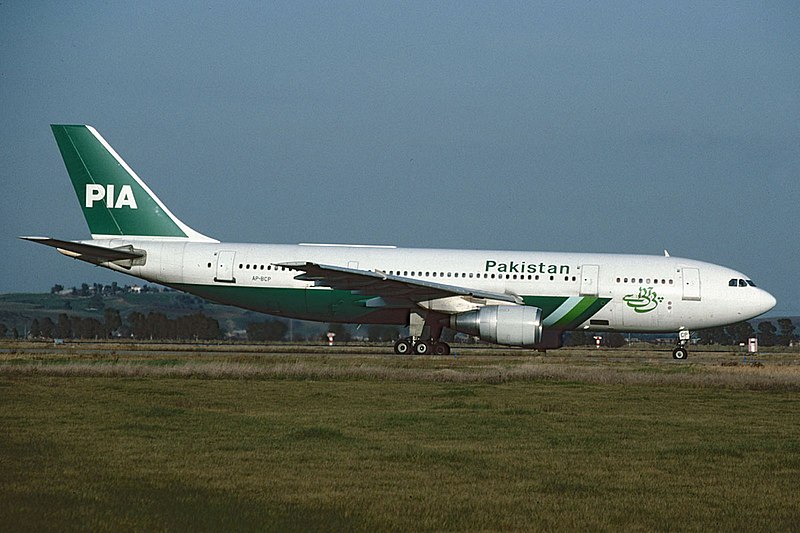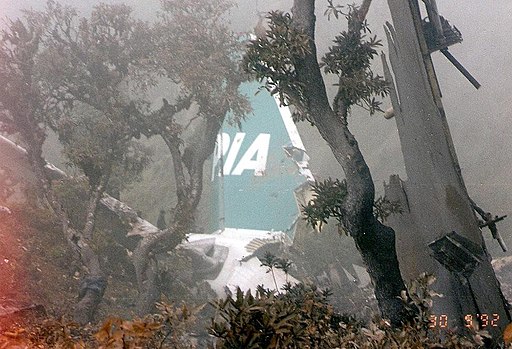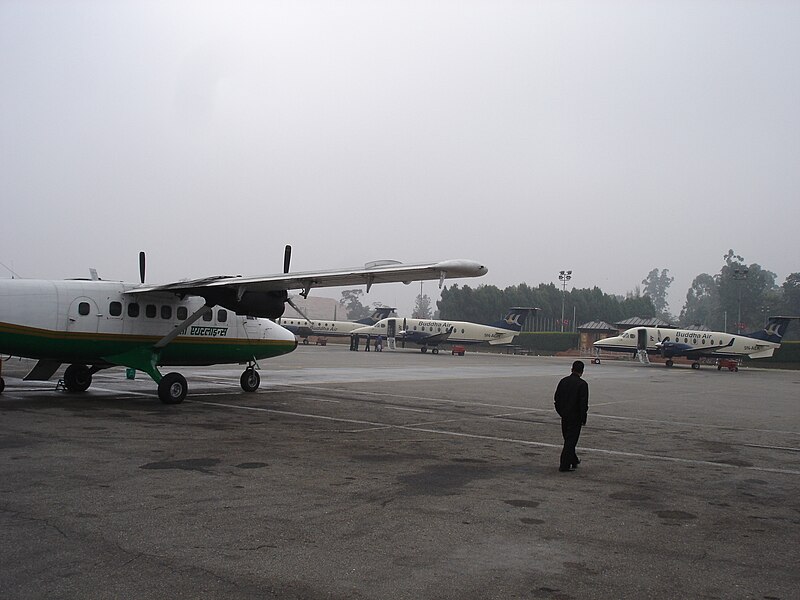Nepal is a nation that has many abandoned airports. When an aircraft first landed in Nepal, it was in a field where cows grazed– hence the name Gauchar Airport. This was pretty reminiscent of Lukla Airport– the most dangerous airport in the world – where when just before the first aircraft landed, grazing cows and playing kids had to be cleared off the runway. Development of aviation in this nation has been pretty slow, and aviation technologies too. The accident of Pakistan International Airlines flight 268 – the biggest aircraft incident in Nepal – is one such glaring example.

Photo: Guido Allieri | Wikimedia Commons
Sketches of Nepal’s biggest aircraft accident
On September 28, 1992, AP-BCP Flight 268, an Airbus A300B4-203, took off from Karachi International Airport (KHI) to perhaps the most well-known among the international airports of Nepal – Kathmandu’s Tribhuvan International Airport (KTM). The flight had 165 passengers and 12 crew members. Captain Iftikhar Janju, with nearly 13,000 flight hours, and First Officer Hasan Akhtar, with about 6,000 hours, were in command.
After entering Nepal’s airspace, the pilots requested and received landing clearance from air traffic control (ATC) at an altitude of 11,500 feet. The aircraft needed to descend to 5,800 feet in a seven-step approach, as the terrain surrounding Kathmandu required careful navigation.
At that time, Tribhuvan Airport lacked radar, so the crew had to inform ATC of their altitude and location. After contacting ATC, the First Officer reported, “One six due at eleven thousand five hundred,” indicating readiness to land. ATC then instructed them to proceed to SIERRA, and the pilots were expected to respond at D10. Minutes later, the First Officer confirmed they were at D10, and ATC inquired about their altitude.
The pilots reported, “We have crossed 8,500 feet; now we have crossed 5,200 feet” ATC cleared them for runway 02 and instructed them to report at 4 DME. However, the expected report at 4 DME did not come. A few seconds later, while descending through 7,200 feet, the aircraft crashed into a mountain in Lalitpur district, resulting in the deaths of all crew members and passengers, making it one of the largest aviation disasters.

Photo: Coolgenx1 | Wikimedia Commons
There was no defect in the aircraft, yet the crash occurred. Just two months prior, a Thai Airlines Flight 311, a similar aircraft, had attempted to land on runway 02 and crashed, killing 113 people. In just two months, two planes had crashed in Kathmandu, leading to a total of 280 fatalities.
Initial theories as to why PIA Flight 268 crashed
This raised questions about the issues at Tribhuvan Airport and the reasons behind the crash of AP-BCP Flight 268. Following the crash, police and health assistants arrived at the site within minutes. Due to the fire, the surrounding area was severely burned, with only the tail of the aircraft visible. To investigate the incident, the Nepalese government formed a team led by Andrew Robinson.
They found the DFDR and Cockpit Voice Recorder (CVR). Only after analyzing these two can the cause of the accident be determined. The data needed to be downloaded and analyzed, so it was sent to France. Before the data analysis began, researchers started to speculate on the possible reasons behind the accident.
- Is it because of weather?
- May be the aircraft got out of control
- Engine failure
- Terrorist attack (Maybe?)
Examining the details of PIA Flight 268
Lets examine all the reasons deliberated upon by the researchers who were investigating the reasons behind Nepal’s worst plane crash.
Weather
All the investigators began to examine the crash, considering various factors. They initially thought the weather might be a cause, as conditions can change rapidly in the mountainous region near Kathmandu. The pilot had mentioned a tornado in front of them and indicated they would slightly turn the aircraft. However, the weather change and the turn may not have been the reason for the accident, as the aircraft had just passed the tornado.

Photo: Nuno Nogueira | Wikimedia Commons
An investigator reviewed the weather conditions at the time and found no evidence of severe weather that could have caused the crash. Thus, the evidence was insufficient, and weather was ruled out as a factor.
Was PIA Flight 268 out of control before the disaster?
The crash site was on a slanted area, making it difficult for people to access. However, investigators obtained photos of the site, one of which showed that the right wing of the plane struck the mountain. Just 1.3 meters below the site, they observed cut tree tops. The air from the aircraft alone could not have caused this damage.
This indicates that the aircraft’s flaps were extended. While the Boeing 787’s wings can flex up to 25 ft during turbulence, the Airbus A300B4-203 can extend its flaps to 25 degrees [Compare this to the 17 ft flex of the A350XWB]. The cut tree tops were at that height, suggesting the flaps were indeed deployed. This means the aircraft was either landing or taking off, indicating that the aircraft was under the control of the pilot during the landing procedure.
Ruling out engine failure ?
It was also posited that a bird strike might have led to a loss of thrust, preventing the engine from providing enough power. After all, bird strikes are pretty common around Kathmandu Airport, prompting the Civil Aviation Authority of Nepal (CAAN) to implement a structured policy prevent to bird strikes.

However, investigators of PIA 288 quickly found a that the fan blades of the engine were still running at the time of the crash. The pilots were operating the engine at low thrust, indicating they were attempting to land, which ruled out bird strike / engine failure as a cause.
May be terrorist attack
After the investigators found no technical issues, they began to consider the possibility of a terrorist attack. If the aircraft had been hijacked or involved in other criminal activities, the cockpit voice recorder would have captured all conversations that occurred in the cockpit. The investigators then started to listen to the cockpit data and made their findings:
- First officer was talking to the ATC officer
- And Pilot was commanding to the passenger to fasten the seatbelt
When the First Officer communicated with ATC, the conversation remained relaxed and normal, showing no signs of stress. The crash occurred just 30 seconds after this conversation, making it difficult to conclude that it was a terrorist attack. Given the presence of the four guards on board, it would have been challenging to overpower them and execute a crash in such a short time.
Finding the probable causes behind Nepal’s worst plane crash
All the investigators’ assumptions regarding what might have happened with PIA Flight 268 were proving to be incorrect. After all, the aircraft was fully functional, and the pilots were in control.
However, the investigators had a starkly important revelation: The aircraft was flying at a lower altitude than required. It had to be at an altitude that was 1,000 feet higher.
As mentioned earlier, any aircraft needed to follow a seven-step approach, and if AP-BCP Flight 268 had adhered to these steps, it should have been at least 1,000 feet higher. The insights from black box also confirmed this. When the First Officer reported they were at 11,500 feet, they were actually at 10,500 feet, and they continued to fly below the required altitude by 1,000 feet. This raised many questions: Why were the pilots flying 1,000 feet low? Why didn’t they notice this? What was happening in the cockpit? Questions also arose regarding ATC: Why didn’t air traffic control communicate properly?
The investigators soon found answers. At that time, there was no radar at Tribhuvan Airport, so the crew had to inform ATC of their altitude and location. The primary responsibility of ATC was to oversee the seven-step approach. Here are a few noteworthy points:
- When the aircraft was at 16 Distance Measuring Equipment (DME), the required altitude was 11,500 feet, but they were at 10,500 feet.
- At 10 DME, the First Officer reported 8,200 feet, while the required altitude at that point was 9,500 feet.
This alerted ATC that the aircraft was below the required altitude. However, ATC did not take action because, during landings at Tribhuvan Airport, many aircraft often flew at lower altitudes due to clouds and tornadoes, intending to return to the required altitude afterward.
But if we read the final report of investigation we can see “10 DME was a missed opportunity to prevent the accident but, even if he had done so, it is doubtful whether the accident could have been averted”.
After all of this, one question remains: Why was the aircraft flying 1,000 feet low? Captain Iftikhar Janju had landed in Kathmandu seven times, but it was not a frequent destination for PIA’s A300 crews, and neither pilot had operated there in the previous two months. Additionally, the pilot chose a visual approach.
The main mistake occurred at 16 DME, three minutes before the crash, when the First Officer reported they were at 11,500 feet, but they were actually at 10,500 feet. The pilot relied on a chart rather than the altitude meter, which contributed to the crash. There is no exact reason to explain why the aircraft crashed or why the pilot was flying at a low altitude, but there are a few explanations related to the chart, as noted by the investigators.
- “Investigators thought that contributory causal factors included the inevitable complexity of the approach and the associated approach chart.” As mentioned, PIA’s A300 were not heading to a frequent destination, leading to a lot of pressure on the Captain and First Officer, which may have hindered their ability to analyze the chart properly.
- According to the aircraft design, the crew could only place the chart in two locations: in front of the pilot or on the left side. If they placed the chart on the side, it would complicate continuous viewing. Therefore, the pilots may have chosen to place the chart in front of them, but this would require positioning it farther away Given the complexity of the chart and the abundance of information, it would have been difficult to read effectively.
As a result, they were flying at a lower altitude than required, not following the chart, and unaware that they were off course. Another possible cause is the “thumb theory.”
- When the pilot was viewing the chart, the thumb may have obscured the first piece of information. If the thumb hid the 16 DME mark, it would conceal 11,500 feet, leaving only 10,500 feet visible.. If the pilot continued to follow the approach, they would see 9,500 feet at 13 DME and 8,200 feet at 10 DME—numbers that the First Officer reported to ATC. The pilot may have missed the first mark, which caused them to misread all subsequent marks, resulting in the aircraft flying 1,000 feet lower than the required altitude.
How Nepal’s deadliest crash led to the installation of radar in the nation
After the report was published, several recommendations were made to the aircraft company and Tribhuvan Airport. They suggested creating a clip for the chart and installing radar at the airport. Additionally, there was room for improvement in the SIERRA approach and its associated charts. This tragic accident, the largest in Nepal’s aviation history, occurred due to a small mistake that could have been avoided.
